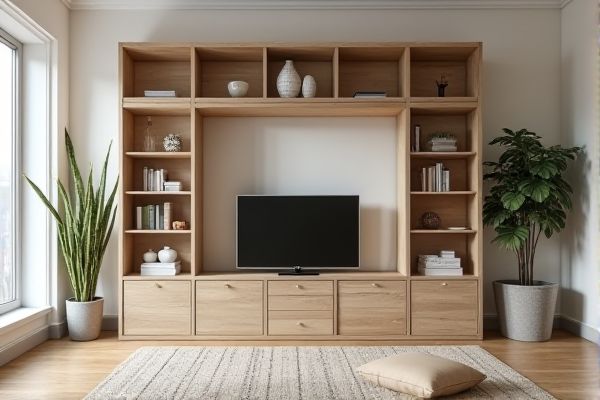
Cube storage and shelving units offer versatile organization solutions, with cube storage providing modular compartments ideal for categorizing items, while shelving units offer open, adjustable space suited for larger objects. Explore the rest of the article to determine which option best fits your storage needs and enhances your room's functionality.
Table of Comparison
| Feature | Cube Storage | Shelving Unit |
|---|---|---|
| Design | Compartmentalized cubes for organized storage | Open shelves for flexible storage options |
| Use Case | Best for storing bins, books, decor items separately | Ideal for larger items and display purposes |
| Material | Typically wood, MDF, or plastic cubes | Wood, metal, or glass shelves |
| Customization | Modular and stackable cubes | Adjustable shelf heights, interchangeable parts |
| Space Efficiency | Compact, defined storage areas | Open and versatile, may occupy more space |
| Accessibility | Easy to access individual cubes | Easy access to all items on open shelves |
| Weight Capacity | Moderate, depends on cube material | Higher weight support on sturdy shelving units |
| Cost | Generally affordable and budget-friendly | Varies, often higher depending on materials |
Introduction to Cube Storage and Shelving Units
Cube storage and shelving units both offer versatile solutions for organizing spaces, but they differ in design and functionality. Cube storage typically features open compartments or cubbies, ideal for storing items in a structured, modular format that adapts to various needs. Your choice depends on whether you prefer the compartmentalized organization of cube storage or the open, adjustable shelving often favored for displaying larger items.
Key Differences Between Cube Storage and Shelving Units
Cube storage offers compartmentalized sections ideal for organizing smaller items and decorative pieces, while shelving units provide open, continuous surfaces suitable for larger or bulkier objects. Cube storage often features uniform, cubical slots creating a modular design that enhances versatility in arranging items, whereas shelving units prioritize height and adjustable shelf spacing for accommodating various object sizes. The key difference lies in cube storage's emphasis on segmented storage versus shelving units' focus on flexible, open storage options.
Design and Aesthetic Comparisons
Cube storage units feature a modern, modular design that creates a clean, geometric look ideal for contemporary spaces, offering customizable compartments for personalized organization. Shelving units come in various styles from traditional to industrial, providing open, airy displays that emphasize vertical space and easy access to items. Both options offer versatile aesthetics, but cube storage emphasizes symmetry and compartmentalization, while shelving units prioritize openness and visual flow.
Storage Capacity and Organization
Cube storage offers customizable compartments that maximize your storage capacity by fitting various-sized items neatly, while shelving units provide open, horizontal surfaces ideal for larger or frequently accessed belongings. Cube storage units often come with bins or drawers, enhancing organization by categorizing small items efficiently, whereas shelving units allow for easy visibility and access but may require additional containers to prevent clutter. Your choice depends on whether you prioritize modular organization or straightforward, versatile storage space.
Material and Durability Considerations
Cube storage units often feature robust materials like engineered wood or plastic, offering durability and resistance to wear and moisture, ideal for long-term use. Shelving units are typically constructed from metal, solid wood, or particleboard, with metal shelves providing superior load-bearing capacity and longevity in heavy-duty environments. Material choice directly impacts durability, with metal shelving excelling in industrial settings while cube storage suits versatile, moderate-duty applications.
Ease of Assembly and Installation
Cube storage units typically offer straightforward assembly with simple interlocking panels and minimal tools required, making them ideal for quick setup. Shelving units often involve more complex installation, including securing brackets to walls for stability, which may require drills and anchors. The ease of assembly and installation makes cube storage a preferred choice for users seeking hassle-free organization solutions.
Versatility and Placement Options
Cube storage offers enhanced versatility with modular design, allowing users to customize configurations to fit varying spaces and storage needs, making it ideal for both small apartments and large rooms. Shelving units provide fixed-tier storage, often limiting placement options due to their rigid structure and size. Cube storage's adaptability supports horizontal or vertical arrangements, increasing usability in corners, closets, or as room dividers, whereas shelving units typically require wall support or floor clearance, restricting flexibility.
Cost Comparison of Cube Storage vs Shelving Units
Cube storage units generally offer a more budget-friendly option, with prices ranging from $20 to $100 depending on size and material, making them suitable for smaller spaces and lighter loads. Shelving units, often constructed from metal or solid wood, typically cost between $50 and $300, reflecting their durability and higher weight capacity for items like books and equipment. Considering long-term value, shelving units may provide better durability, whereas cube storage excels in modularity and affordability for casual storage needs.
Maintenance and Cleaning Requirements
Cube storage units typically require less maintenance as their smooth surfaces allow for easy dusting and wiping, whereas shelving units with open slats or intricate designs may accumulate more dust and require frequent cleaning. Materials like plastic or laminate used in cube storage resist stains and moisture, reducing the need for special cleaning agents compared to wooden shelving units that might need polish or protective treatments. Regular maintenance for shelving units often involves tightening screws and checking for structural integrity, while cube storage's modular design generally demands minimal upkeep.
Which Storage Solution Is Right for You?
Cube storage offers versatile, modular compartments ideal for organizing smaller items and customizable layouts that adapt to your space and needs. Shelving units provide open, accessible surfaces perfect for displaying larger items or books, allowing easy visibility and quick access. Your choice depends on whether you prioritize compartmentalized storage flexibility or straightforward, spacious display options.
 homyna.com
homyna.com